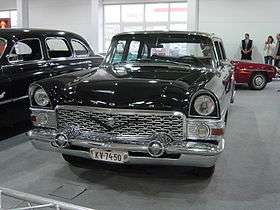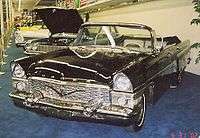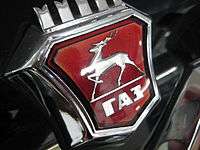GAZ Chaika
A Chaika (Russian: Ча́йка), which means gull, is a luxury automobile from the Soviet Union made by GAZ. The vehicle is one step down from the ZIL limousine. Chaika production consisted of two generations, the M13 of 1959 to 1981 and the M14 of 1977 to 1988.
M13 Chaika
| M13 Chaika | |
|---|---|
 | |
| Overview | |
| Manufacturer | GAZ |
| Production | 1959-1981 (first prototype made in 1955 or 1956) |
| Body and chassis | |
| Class | Full-size luxury car |
| Layout | FR layout |
| Powertrain | |
| Engine | 5.5 l M-13 V8 |
| Transmission | 3-speed automatic |
| Dimensions | |
| Wheelbase | 3,250 mm (128.0 in) |
| Length | 5,600 mm (220.5 in) |
| Width | 2,000 mm (78.7 in) |
| Height | 1,580 mm (62.2 in) |
| Curb weight | 2,050 kg (4,519 lb) |
| Chronology | |
| Predecessor | GAZ-12 ZIM |
| Successor | M14 Chaika |
The Mark 1 Chaika, the GAZ M13, debuted in 1958.[1] It was produced from 1959 to 1981, with 3,179 built in all.[2] The M13 was powered by a 195-hp SAE gross 5.5 L V8 and driven through a push-button automatic transmission of a similar design to the Chrysler TorqueFlite unit. It was offered as a saloon (GAZ 13), limousine (GAZ 13A), and four-door cabriolet (GAZ 13B) with an electrohydraulic top.[3] The cabriolet was made in 1961 and 1962 for official parades.[4]
RAF in Riga produced the GAZ 13A Universal, an estate, in the 1960s in Riga; this was also built as the GAZ 13C ambulance, as well as a hearse.[5] Produced for a few years in the 1960s, it is the lowest-volume Chaika variant. Small numbers were also built for Mosfilm.[6] As a limousine-class car, Chaikas were available only to the Soviet government, and could not be purchased by average citizens. However, citizens were allowed to rent Chaikas for weddings. Chaikas were used by Soviet ambassadors and Communist Party First Secretaries in East Germany, Korea, Bulgaria, Hungary, Mongolia, and Finland, among others; Fidel Castro was given one by General Secretary Nikita Khrushchev, who himself preferred the Chaika to his ZIL,[7] and kept one at his summer dacha. He also presented one limousine version each to both King Sisavang Vatthana of Laos and Prime Minister, Prince Norodom Sihanouk of Cambodia on their visits to the Soviet Union.[8] For their larger size and more powerful V8, Chaikas were also ordered in some quantity by the KGB. Top speed was 99 mph (159 km/h).
Most Chaikas were saloons. The M13B was built for only two years 1961 and 1962. The GAZ 13 was discontinued in 1981.[9] The M14 debuted in 1977,[10] and ran to the end of Chaika production in 1988. Enthusiasts often point to the 1955-56 U.S. Packards as the inspiration for the early Chaika's styling. Nevertheless, Packards of 1955-56 are also have a lot in common with earlier Soviet concept ZIS-112 "Odnoglazka" (1951).
| Engine | Power | Transmission | wheelbase | length | suspension |
|---|---|---|---|---|---|
| 8-cylinder | 220 hp SAE gross [11] | 3-speed | 135.8 in (3,449 mm) | 240 in (6,096 mm) [12] | Front: independent with coil springs |
.jpg) Front view
Front view Rear view. Notice the tailpipe integrated in the rear bumper as well as the late-1950s American-style tailfins.
Rear view. Notice the tailpipe integrated in the rear bumper as well as the late-1950s American-style tailfins. Sedan version
Sedan version Cabriolet
Cabriolet GAZ logo
GAZ logo- M13 interior
M14 Chaika
| M14 Chaika | |
|---|---|
|
| |
| Overview | |
| Manufacturer | GAZ |
| Production | 1977-1988 (first prototype dated as early, as 1967) |
| Body and chassis | |
| Class | Full-size luxury car |
| Layout | FR layout |
| Powertrain | |
| Engine | 5.5 l GAZ-14 V8 |
| Dimensions | |
| Wheelbase | 3,450 mm (135.8 in) |
| Length | 6,114 mm (240.7 in) |
| Width | 2,020 mm (79.5 in) |
| Height | 1,525 mm (60.0 in) |
| Curb weight | 2,615 kg (5,765 lb) |
| Chronology | |
| Predecessor | M13 Chaika |
The vintage 1950s-style M13 was succeeded by the more modern Chaika M14 introduced in 1977 (although production of both versions overlapped by several years). Although visually modern and fitted with the latest electronic luxury features, the M14 was in fact built around the drivetrain and undercarriage of the older model.[13] The M14 engine was a modernized 5,526 cc (337.2 cu in) and achieved 220 hp SAE gross.[14] A seven-seater, with special soundproofing,[15] it measured 611 cm (241 in) long overall and weighed in at 2,600 kg (5,732 lb).[16] A four-door convertible, the 14-95, appeared in 1982.[17]
The Chaika M14 remained in production from 14 October 1977 to 1988,[18] when the Chaika limousine brand was ended.
Around a hundred M14s were built each year, with total production (including those out of spares in 1989) reaching 1,114.[19] On orders from Mikhail Gorbachev, the blueprints and tooling were destroyed as part of his "fighting privileges" campaign under perestroika.[20]
 GAZ-14 "Chaika"
GAZ-14 "Chaika" Rear view
Rear view- Interior
 GAZ-14-05 "Chaika"
GAZ-14-05 "Chaika"
Trivia
- The Hungarian Railway Museum features a Chaika that has been converted to travel on rails.
References
- ↑ Thompson, Andy. Cars of the Soviet Union (Haynes Publishing, Somerset, UK, 2008), p.69.
- ↑ Thompson, p.70.
- ↑ Thompson, p.70.
- ↑ Thompson, p.70.
- ↑ Thompson, p.70.
- ↑ Thompson, p.70.
- ↑ Thompson, p.70.
- ↑ https://news.google.com/newspapers?nid=799&dat=19680115&id=2tUOAAAAIBAJ&sjid=MUgDAAAAIBAJ&pg=1800,646733&hl=en
- ↑ Thompson, p.70.
- ↑ Thompson, p.70.
- ↑ World Cars 1978. Herald Books. ISBN 0-910714-10-X.
- ↑ World Cars 1978. Herald Books. ISBN 0-910714-10-X.
- ↑ Thompson, p.211.
- ↑ Thompson, p.211.
- ↑ Thompson, p.211.
- ↑ Thompson, p.212.
- ↑ Thompson, p.305.
- ↑ Thompson, pp.211-212.
- ↑ Thompson, p.305.
- ↑ Thompson, p.305.
External links
| Wikimedia Commons has media related to Chaika. |
| Type | 1960s | 1970s | 1980s | 1990s | 2000s | 2010s | ||||||||||||||||||||||||||||||||||||||||||||||||||||||
| 0 | 1 | 2 | 3 | 4 | 5 | 6 | 7 | 8 | 9 | 0 | 1 | 2 | 3 | 4 | 5 | 6 | 7 | 8 | 9 | 0 | 1 | 2 | 3 | 4 | 5 | 6 | 7 | 8 | 9 | 0 | 1 | 2 | 3 | 4 | 5 | 6 | 7 | 8 | 9 | 0 | 1 | 2 | 3 | 4 | 5 | 6 | 7 | 8 | 9 | 0 | 1 | 2 | 3 | 4 | 5 | 6 | 7 | 8 | 9 | |
| Executive car | GAZ-21 Volga | |||||||||||||||||||||||||||||||||||||||||||||||||||||||||||
| GAZ-24 Volga | GAZ-24-10 Volga | GAZ-31029 Volga | GAZ-3110 Volga | GAZ-31105 Volga | ||||||||||||||||||||||||||||||||||||||||||||||||||||||||
| GAZ-3102 Volga | ||||||||||||||||||||||||||||||||||||||||||||||||||||||||||||
| GAZ-3105 Volga | GAZ-3111 Volga | GAZ Siber | ||||||||||||||||||||||||||||||||||||||||||||||||||||||||||
| Luxury car | GAZ M13 Chaika | |||||||||||||||||||||||||||||||||||||||||||||||||||||||||||
| GAZ M14 Chaika | ||||||||||||||||||||||||||||||||||||||||||||||||||||||||||||
| LCV | GAZ GAZelle | |||||||||||||||||||||||||||||||||||||||||||||||||||||||||||
| GAZelle NEXT | ||||||||||||||||||||||||||||||||||||||||||||||||||||||||||||
| Truck | GAZ-51 | GAZ-3307/3309 | ||||||||||||||||||||||||||||||||||||||||||||||||||||||||||
| GAZ-63 | GAZ-3308 Sadko | |||||||||||||||||||||||||||||||||||||||||||||||||||||||||||
| GAZ-53 | GAZ-3310 Valdai | |||||||||||||||||||||||||||||||||||||||||||||||||||||||||||
| GAZ-66 | GAZon NEXT | |||||||||||||||||||||||||||||||||||||||||||||||||||||||||||